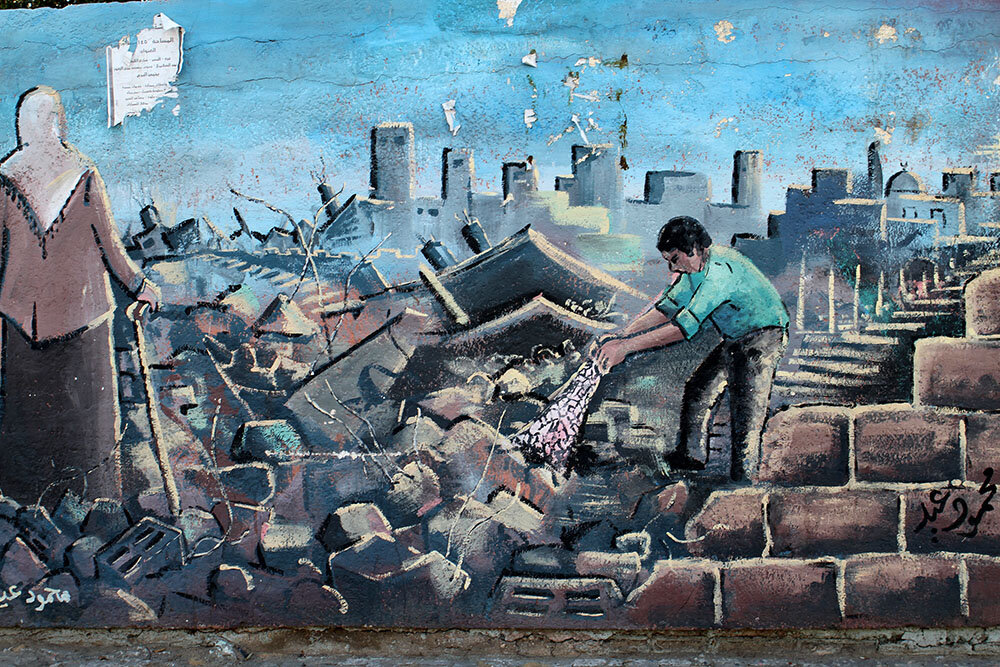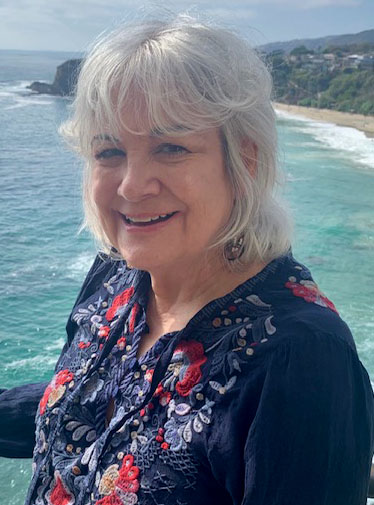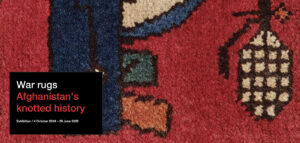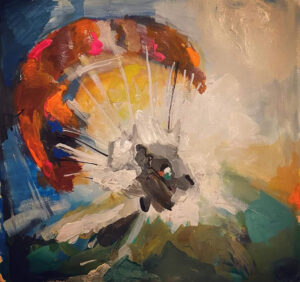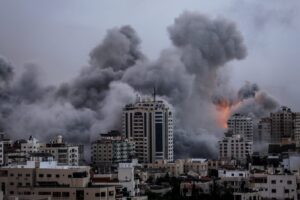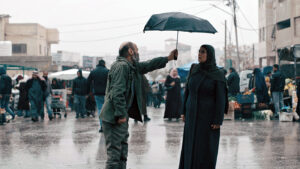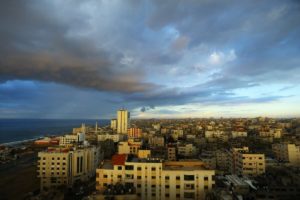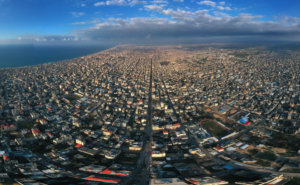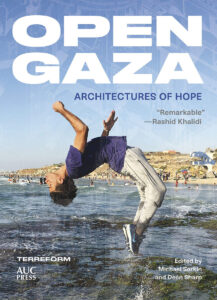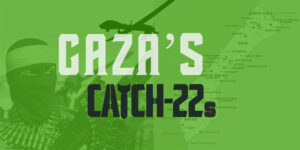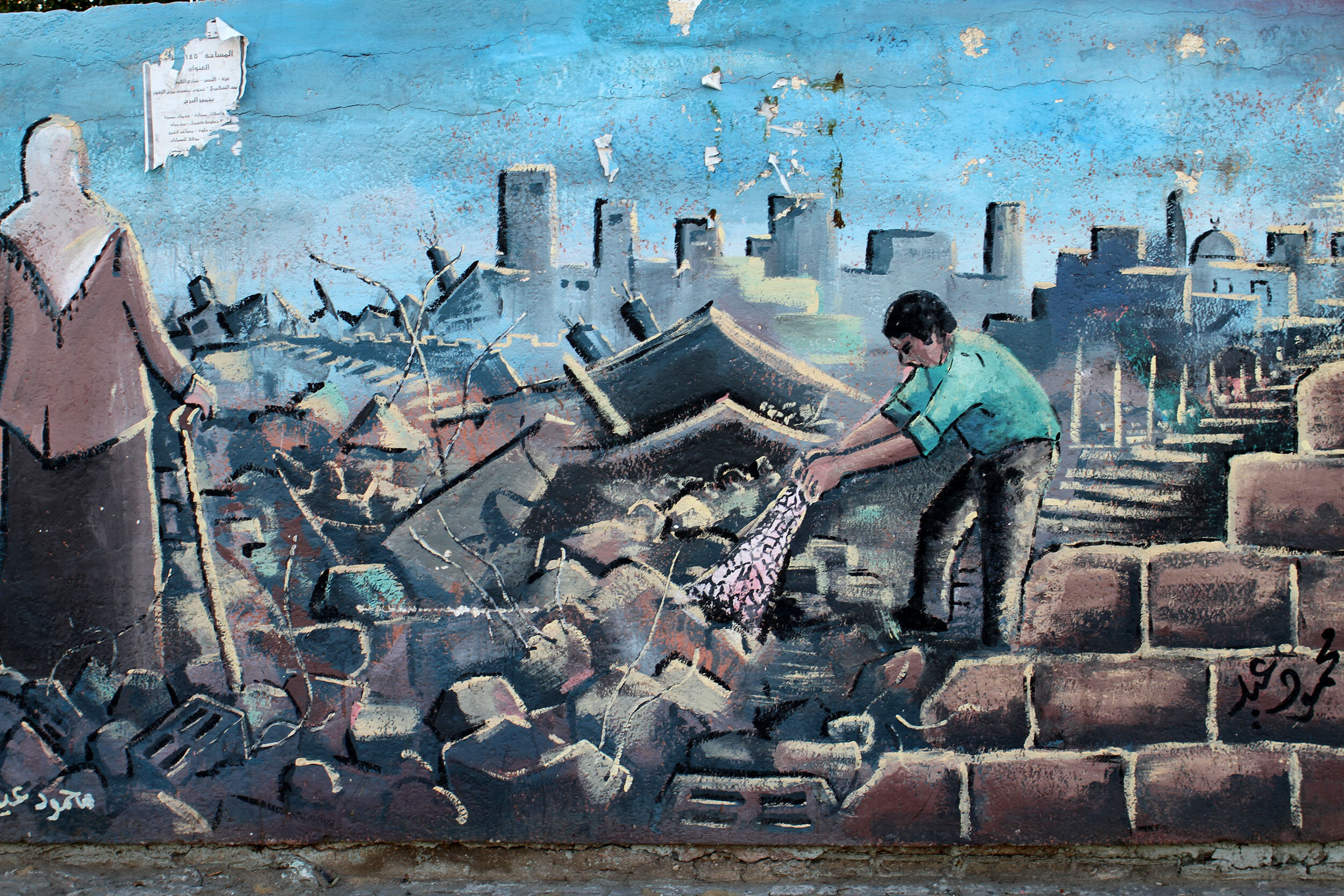
A mural in Gaza records its destruction under the bombs (photo courtesy Larry Johnson).
Diane Shammas
A native of Southern California, I have always supported Palestinians’ right to self-determination, and thus when the opportunity arose, I fulfilled a dream by traveling each year for five years to Gaza. I am of Lebanese ancestry on my father’s side of the family and like many youths in what our elders called the Greater Syrian community, I grew up hearing about the history of Palestinian dispossession, which they call the Nakba, or “catastrophe.” I would devour each feature on Palestine in the monthly issues of the American Near East Refugee Agency (ANERA) that my father thoughtfully would put at the foot of my bed after he received each mailed publication.
My first visit to Gaza was with the CODEPINK: Women for Peace delegation in May 2009, five months after Operation Cast Lead. For those who are not familiar with Gaza, it is a coastal strip measuring about twenty-five miles long by five miles wide. Israel and Egypt control its borders. In January 2006, the Change and Reform Party (Hamas) won seventy-four seats out of 132 seats and Fatah, only forty-five seats, in a parliamentary election closely monitored by former President Jimmy Carter. Shortly after Hamas’ victory and takeover of the Palestinian Authority, tensions percolated within the PA, which eventually led to a civil war between the two main political factions, Hamas and Fatah. In May 2007 Hamas won the Battle of Gaza, which set up its power over Fatah in Gaza. In return, Fatah formed a new coalition government that the West backed and recognizes as the legitimate Palestinian Authority. The resulting split into two Palestinian governments, Hamas and Fatah (Palestinian Authority), prompted Israel and Egypt to impose a siege on Gaza.
The siege often is popularized by those who read about or experience Gaza directly as being the world’s largest open-air prison. Entering the 14th year of the siege, Israeli Defense Forces (IDF) still occupy 24/7 the Gaza airspace. Before the siege, the Yasser Arafat International Airport ceased operation in late 2000. The Israeli Navy limits Gazan fishing to three miles out, and from time to time extends to six miles if pressured by the international community (following the United States Convention on the Law of the Sea {UNCLOS}, the international average is twelve nautical miles from the baseline of the territory). The siege enforces crippling restrictions on freedom of movement, travel on Palestinians, quota on food stuffs, ban on construction materials, and restrictions of export (see GISHA). In addition to the siege, it is noteworthy that since 1967, when Israel gained control of Gaza, the state has been engaged in an economic de-development plan of the Strip, as Sara Roy has noted (in “The Gaza Strip: A case of economic de-development,” Journal of Palestine Studies, 17(1), pp. 56-88). In the recent Human Rights Watch report (April 27, 2021), HRW officially declared Israel’s policies against the Palestinian people as constituting crimes of Apartheid, which both the Israeli state and the United States government severely censured.
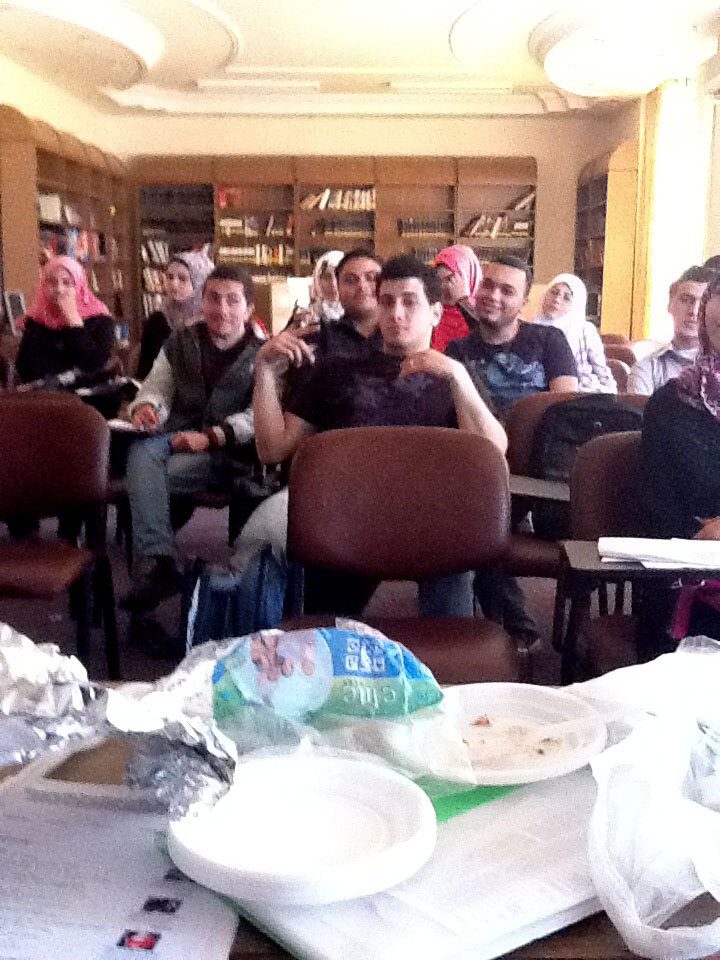
Gazan students in Dr. Shammas’ American studies class at Al Azhar University.
Having a flat topography with restricted access to the world imperils Gaza and makes it particularly vulnerable to Israel’s routine airstrikes, which evokes a generalized anxiety of never being safe. During one of my extended stays in Gaza, Israel launched a month long, aerial bombardment at Hamas’ military bases. These onslaughts inevitably kill or wound any civilian in its path.
Huddling in your flat amidst the somnolent hum of encircling drones and the roar of Black Hawk helicopters or F16s overhead, poised to release bombs on command, the scrambled images on your TV set were a constant reminder of Israel’s surveillance drones, or as Gazans dub them zenana, and that you might be the victim of an attack at any moment. When anxious thoughts of imminent death would stream through my mind, I would cope by blocking out that I was living in a war zone.
The owner of the neighborhood corner store, a tough, rough around the edges chain smoker, would tip me off to what might be an evening of intensifying airstrikes. If I said, “Hey, we are going to have a hot night tonight?” or naively asked, “how would I know if I would survive?” he would reply dispassionately, “If you hear the descending whistle of a falling bomb, you are still alive.”
People often asked me weren’t you frightened, living months at a time in the Gaza Strip? I responded that living there is much different than visiting. You wake up and walk outside as you would in your home in the States. You first greet your landlord, then your neighbors while walking down the street, you pop into your local retailers where you buy your dry goods, vegetables, meat, poultry, and fish. The merchants all get to know you, welcoming you with “Ahlan wa sahlan” and as you exit, “masalaameh.” Two blocks from my apartment was my favorite poultry stand where once every two weeks there would be an outdoor caged display of a Middle Eastern delicacy, live domestic rabbits (al aranab). Missing my own pet rabbits at home, I would ask to cuddle individual ones, realizing that they would meet a hastened death by the end of the day. I often would engage in reverie about rescuing the rabbit and bringing it home to my apartment without my landlord noticing, but would soon ditch the idea, as how could I ever convince the government officials at the crossing to exit with four large suitcases and a bunny in tow?
My most rewarding experiences occurred during three-month stays in Gaza between 2010 and 2012, when I taught at Al Azhar University in Gaza City. My friend, the Dean of the English Department and Director of the American Corner, invited me to teach courses in American Cultural Studies. One of the main aims of the course was to boost students’ oral and written skills in English through content-based material. In the spring of 2012, I patterned my course after a similar course that I taught at the University of Southern California in the Department of American Ethnic Studies. The course examined how the social construction of race in the United States curtailed the citizenship rights of African Americans, Latinx, Asians, indigenous groups, Arab Americans and Muslim Americans.
After the course I conducted a survey that revealed striking findings on how Palestinian students viewed racial, economic, and gender disparity in the U.S. vis a vis their own. Many students’ beliefs stemmed from how the crippling siege has prevented students from meeting up with Americans. Prior to taking the course, a sizeable number of the students were aware of the racial problems in the United States, but less aware of the deepening chasm between rich and poor in our country to the extent that over half of the students reported that there were no American children living under the poverty line. After the course, students responded that culturally they most identified with Arab and Muslim Americans. They also expressed solidarity with the dispossession of American Indians, and engaged in the historical tradition of boycott among African Americans.
Students’ journal entries and creative writing pieces illuminated a critical pedagogical outcome of the course as far as they served as a cathartic outlet to unleash students’ anguish under siege and occupation and to relate their life histories to what they learned about settler colonialism, racism, and classism in the United States.
The class discourse centered on the concept of whiteness, which is based on how the dominant culture perceives one’s phenotype and racial group associations. As the family is the focal point of Palestinians’ lives, Langston Hughes’ short story, Passing, affectively drew students to the Black character, who assumes white identity and laments that he felt compelled to pass up his mother on the streets without acknowledging her.
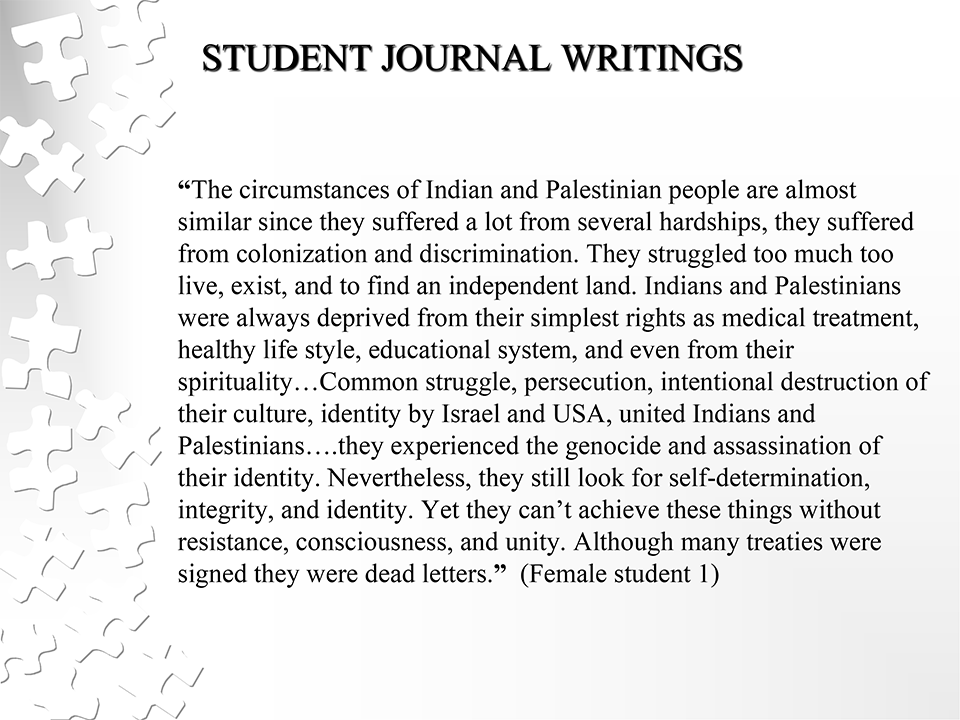
Although within Gazan society a small percentage of its citizens are descendants of Africa, the Philippines, and the former Soviet Union, diversity is seen more in terms of differences in religion and political affiliation or being a refugee versus a native from Gaza. Viewed as potentially explosive and divisive topics, vocal participants in the class divulged that prejudice against Palestinian Christians existed in Gaza, but one student interjected that Palestinian refugees and Gazan natives also harbor biases against each other to the extent that both are more likely to practice endogamy.
One female student, Manar (with the exception of Ismail, hereafter pseudonyms are given for the university students to safeguard their identity), pointed to the shared history of American Indians and Palestinians, from ethnic cleansing to flouted peace treaties and accords that merely served as pretexts for further colonization and land expansion. In her journal entry she wrote: “Indians and Palestinians were always deprived from their simplest rights as medical treatment, healthy lifestyle, educational system, and even from their spirituality.” She added, “Common struggle, persecution, intentional destruction of their culture, identity by Israel and USA, united Indians and Palestinians….they experienced the genocide and assassination of their identity. Yet they can’t achieve these things [alluding to self-determination, integrity, and identity] without resistance, consciousness, and unity. Although many treaties were signed, they were dead letters.” One telling similarity between American Indians and Palestinians is that both taught their colonizers how to harvest their crops (as Ilan Pappe noted in a keynote address he gave at the Palestine Children’s Relief Fund’s Healing Hands Conference in Anaheim in 2010).
Acquiring new knowledge from the course, such as America’s legacy of the civil rights movement, changed students’ perceptions about the United States, and as predicted, prompted some students to compare the organized transportation boycotts of the Jim Crow Era with their own Palestinian civil society campaign for BDS, the boycott, divestment, and sanctions against Israel. As one class member reflected in his journal, “it added to my knowledge of information that I didn’t know about the United States’ history, and movements that struggled for freedom. The history of racial groups and our history as Palestinians are similar and boycott against Israel and boycott in the United States.”
Unbeknownst to most Americans, Palestinians have their own legacy of non-violent popular resistance, dating back to the early 1930s, which rarely receives coverage in the mainstream news (cf. Mazin B. Qumsiyeh, Popular Resistance in Palestine, Pluto Press 2011).
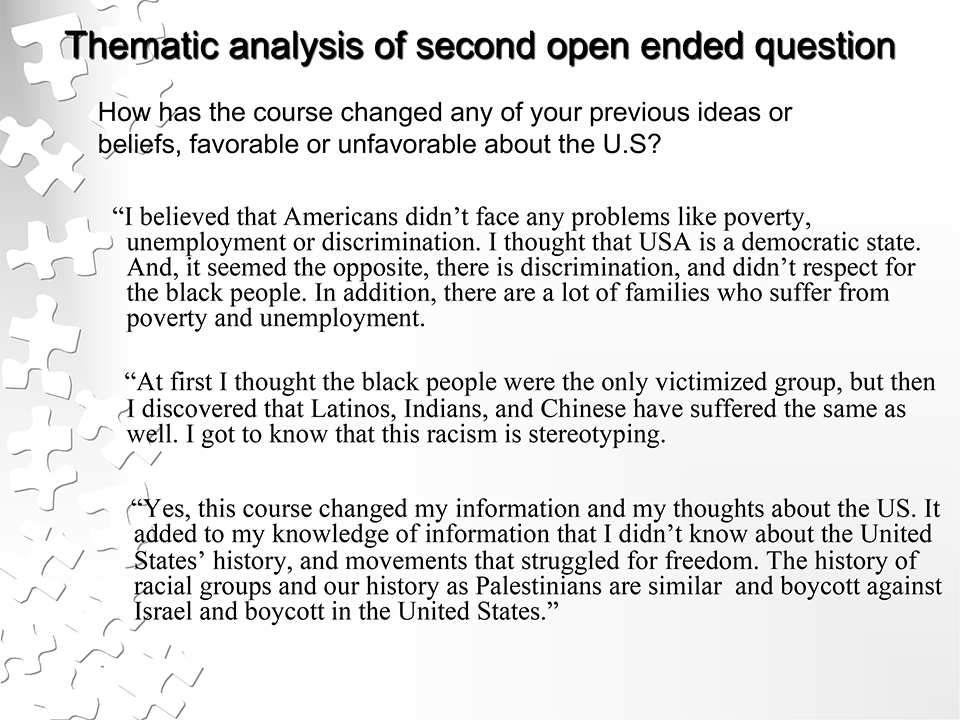
Two years after teaching this course, something curious and beautiful occurred, when a coalition of African Americans and Palestinians sprung up in solidarity. In the fall of 2014, after Israel’s genocidal assault on Gaza and the police killing of Michael Brown in Ferguson, Missouri, Palestinian activists inside Palestine and outside tweeted messages of solidarity with Michael Brown’s family and Ferguson protesters.
Similarly, in 2015, a coterie of U.S. activists from Black Lives Matter and other racial justice groups, formed the Palestinian-American led Dream Defenders‘ delegation, embarked on a ten-day visit to the West Bank, East Jerusalem, and Israel in order to build alliances.
— • —
You might wonder what has become of the students that I taught? I followed the progress of three of the students amidst their struggle to rebound from Israel’s last devastating war on Gaza in the summer of 2014. Emani, one of the most introspective of the class, has managed to complete her master’s degree in business administration while carving out a few hours a day to take up dressage at Gaza’s only equestrian club — not always viewed as a befitting past time for a woman living in a traditionally patriarchal, albeit gender transitioning society. On her Facebook page Emani posts daily videos of her Arabian mare, which she arranged for her delivery through the Erez crossing. In these captioned videos we see and feel Emani anthropomorphizing the young mare, Praemia, by gingerly wiping off a tear trickling from her eye, and the bonding of a human and an animal as Emani and Praemia engage in a preliminary lunge training session.
Recently, Emani and Praemia were mourning as there is a shortage of hay in Gaza as Kerem Shalom had shut down their facility for two weeks. Hay is a staple food for horses and farm animals, and many of the horses at the stable are becoming malnourished due to the scarcity of hay. I asked, “Should I arrange for someone to bring seeds into Gaza to plant hay?” Alas, she said that there was not enough empty space to grow rows of hay, so they are forced to buy it off the shelf from the occupying force. Whether they supply Gaza or not, Israel profits from the occupation.
Ismail, “my little poet” in the class, is still writing, but it seems as if he has switched his genre from poetry to a social realism prose. He recently contributed a feature story, “Scarcity No Match for Creativity” for the We are Not Numbers project. Ismail relates the story of a resourceful female artist who substitutes lipstick, eyeliner, eye shadow, foundation, and spices for charcoal pencils, and chalk — art supplies that are not only dear, but also not available in Gaza. She even uses hair spray to set the dye of the colors on the charcoal sketches. In the Middle East Eye, Ismail recounts a “Diary of Pain,” the night that both his parents, his two brothers, and a four-year old nephew perished from an Israeli airstrike that descended upon his home during the al Fajr (dawn) prayer. He recalls a nostalgic moment when his mother was reciting her favorite poem to him and then, suddenly everything turned white, a shell pierced Ismail’s skull. According to his account, sometime later he awoke dazed with a head trauma at Al Shifa Hospital.
Another student, Anise, speaks English with barely an accent, and an astonishing familiarity with colloquial US English, given that he and other Palestinians in Gaza have little to no access to native American speakers. Inside the classroom he assumed a leadership position as my teacher’s assistant, and outside as my chaperone across Gaza City. (There were very few women who could be escorts as tradition dictated after 5 pm they return home to their families.) Anise and I shared a passion for cooking so we would spend a couple of hours at the few gourmet stores available in Gaza City to select assorted delectables to cook along with the basics. Within the last year Anise launched his own online publishing house; although in its nascent stage, it is showing positive signs of modest growth in terms of recruiting a marketing and development team. With the support of my recommendations, Anise attended a master’s program in international education in a New Delhi university, and a summer exchange program at a prominent East Coast university, which is designed to bring together Israeli and Palestinian students to engage in knowledge sharing, social networking, and source mentoring to accelerate their individual startup proposals. Anise recently has immigrated to Southern California, thirty miles from where I live in Orange County, and is seeking asylum in the United States.
All the students have their own stories, which snowballs into telling more stories about other students, as in the case of Ismail. The portraits of Emani, Ismail, and Anise form an invincible buffer against the tone of racially patronizing questions often asked of me, such as the one by an Israeli hotel executive in Jerusalem. “How is the university where you teach in Gaza?” A presumptuous question, clearly a micro-aggression that assumes Palestinian students are plagued by a cultural deficit, and thus, branding them as low achievers. Absent from this biased assessment is the suffocating siege that brings electrical shortages up to 18 hours a day. Some students switch on their home generators and resume their studies with the hum of the motor laboring in the background; and others less fortunate under the flicker of the gas lanterns by their side. A few students received propitious news of acceptance for study abroad, and even fewer obtain the pass from the Israeli army (COGAT) to exit Gaza. Yet, while they are studying overseas, more students than not yearn to return to their homeland (watan). The following quote of Mahmoud Darwish embodies the paradox of the homeland and traveler, “My homeland is not a suitcase, I am not a traveler.”



